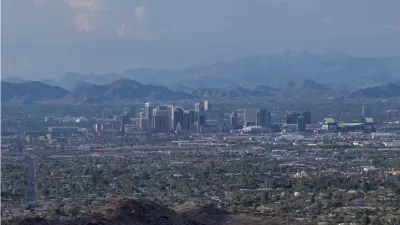Phoenix, once described as 'the world’s least sustainable city' is focusing growth on its downtown and investing in light rail and bike share to attract high tech companies and workers.

"[T]he Phoenix that has been disparaged by so many is undergoing a change," writes Fernanda Santos, Phoenix bureau chief for The New York Times. Santos includes not one but four references to the city's negative reputation.
The change "began when the housing bubble burst and affordable home after affordable home went into foreclosure," adds Santos. "The collapse started in new-housing areas on the fringes [in 2007] and then swept inward, hitting more established areas as the unemployment rate climbed," according to The Arizona Republic
"City officials, intent on revitalizing the place, searched for a new formula, one that focused not on the outer edges of the desert, where there remains plenty of room to expand outward, but on the long-neglected downtown," continues Santos.
These days, there is hardly an empty lot left in the city’s core, and there are as many apartments under construction, or about to be built, as all of those that were built from 1996 to 2008. But, are there enough people to fill them? That is a multibillion-dollar gamble, and Phoenix has gone all in.
Mayor Greg Stanton added transportation to the effort with a successful sales tax measure last summer for extending light rail.
A bike-sharing program survived its first summer, a time of the year when riding a bike, or doing any other outdoor activity for that matter, is borderline heroic.
The thrust of the article is on Stanton attempting to attract Silicon Valley businesses, workers, and millennials to the city, by building a vibrant, dense downtown.
“I don’t want people to move here because we have great golf courses and cheap homes,” Mr. Stanton said in an interview. “What I want is young college graduates from the East Coast moving here, and our college graduates staying here because they see their future here and we have a great urban community.”
FULL STORY: Phoenix Focuses on Rebuilding Downtown, Wooing Silicon Valley

Alabama: Trump Terminates Settlements for Black Communities Harmed By Raw Sewage
Trump deemed the landmark civil rights agreement “illegal DEI and environmental justice policy.”

Planetizen Federal Action Tracker
A weekly monitor of how Trump’s orders and actions are impacting planners and planning in America.

The 120 Year Old Tiny Home Villages That Sheltered San Francisco’s Earthquake Refugees
More than a century ago, San Francisco mobilized to house thousands of residents displaced by the 1906 earthquake. Could their strategy offer a model for the present?

Ken Jennings Launches Transit Web Series
The Jeopardy champ wants you to ride public transit.

BLM To Rescind Public Lands Rule
The change will downgrade conservation, once again putting federal land at risk for mining and other extractive uses.

Indy Neighborhood Group Builds Temporary Multi-Use Path
Community members, aided in part by funding from the city, repurposed a vehicle lane to create a protected bike and pedestrian path for the summer season.
Urban Design for Planners 1: Software Tools
This six-course series explores essential urban design concepts using open source software and equips planners with the tools they need to participate fully in the urban design process.
Planning for Universal Design
Learn the tools for implementing Universal Design in planning regulations.
Clanton & Associates, Inc.
Jessamine County Fiscal Court
Institute for Housing and Urban Development Studies (IHS)
City of Grandview
Harvard GSD Executive Education
Toledo-Lucas County Plan Commissions
Salt Lake City
NYU Wagner Graduate School of Public Service


























